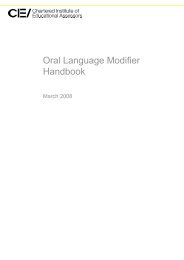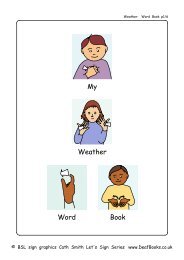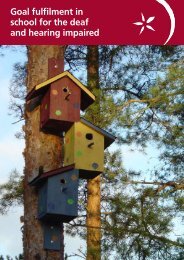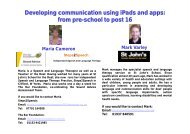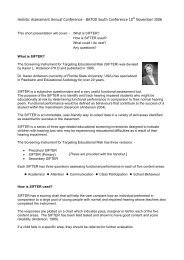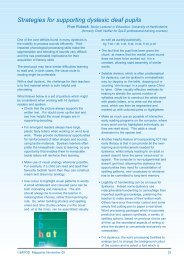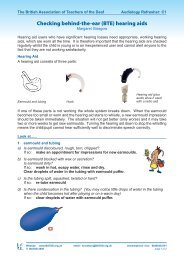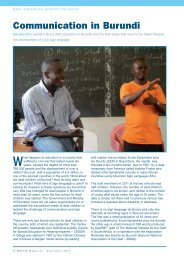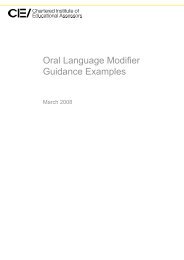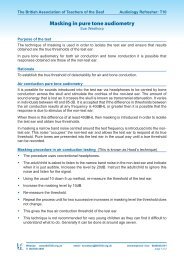Article and examples of instruction sheets - batod
Article and examples of instruction sheets - batod
Article and examples of instruction sheets - batod
You also want an ePaper? Increase the reach of your titles
YUMPU automatically turns print PDFs into web optimized ePapers that Google loves.
South <strong>of</strong> Engl<strong>and</strong> Cochlear Implant Centre<br />
Barb Hay, SOECIC (March 2005) <strong>and</strong> Pauline Cobbold (December 2011)<br />
We developed the Listening Boxes to help parents when both a SLT <strong>and</strong> a ToD were<br />
working with a family. This meant that the ToDs would have quite big gaps between visits.<br />
The Listening Boxes fell into disuse because we failed to get them back because <strong>of</strong> the long<br />
gaps or items were lost by the families.<br />
We needed a lot more <strong>of</strong> the very early ones <strong>and</strong> for various reasons this was not possible.<br />
Some families developed the idea that they could not use their own toys but with others it<br />
helped them focus <strong>and</strong> was very successful.<br />
A small number with local nurseries showing them how they could develop resources based<br />
on the ideas guidance sheet which was left with them.<br />
Barb Hay, a ToD from New Zeal<strong>and</strong> spent some time further developing the boxes <strong>and</strong> her<br />
ideas were very much based on AVT strategies. We still have all the electronic versions <strong>of</strong><br />
the help <strong>sheets</strong> but sadly the actual toys have been lost or reused elsewhere.<br />
Some <strong>examples</strong> <strong>of</strong> the <strong>sheets</strong> are available <strong>and</strong> these can easily be adapted to other books<br />
<strong>and</strong> toys. Please, if the <strong>sheets</strong> are used as a basis for development, note a credit to SOEIC.<br />
Creating a listening box Barb Hay, SOECIC (March 2005)<br />
Listening Boxes evolved from Listening Bags, an idea used by various CI Centres <strong>and</strong><br />
Education teams to provide parents with structured activities to assist the development <strong>of</strong><br />
listening skills. The boxes are used as part <strong>of</strong> the rehabilitation programme for children who<br />
have had cochlear implants.<br />
What are Listening Boxes<br />
Listening Boxes are sturdy, stackable, portable, easily recognisable <strong>and</strong> contain specific<br />
activities, targeting a range <strong>of</strong> particular listening skills. The contents always include toys to<br />
reinforce a particular skill, usually the words to a song or rhyme for parents to sing with their<br />
children (remembering the importance <strong>of</strong> developing pitch, rhythm <strong>and</strong> intonation) <strong>and</strong> a<br />
book for shared reading. The contents are listed on laminated <strong>sheets</strong> which provide advice<br />
<strong>and</strong> step by step <strong>instruction</strong>s on how to use the items effectively.<br />
Why were they developed<br />
Listening Boxes were developed to build up children's listening skills <strong>and</strong> to give parents<br />
specific ideas on how to support their child's listening development. Each box provides ideas<br />
on how children can experience sound in a meaningful <strong>and</strong> fun way. Before parents leave<br />
the Centre the ideas contained in the box are explained, along with suggestions <strong>of</strong> how the<br />
box could be used at home. An underlying aim is to encourage parents <strong>and</strong> families to spend<br />
regular 'quality' time at home reinforcing the skills between visits from centre staff.



